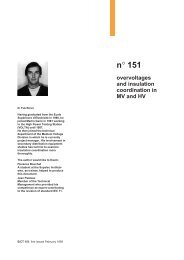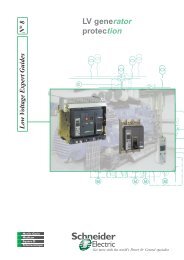sepam 20 user manual - Schneider Electric
sepam 20 user manual - Schneider Electric
sepam 20 user manual - Schneider Electric
You also want an ePaper? Increase the reach of your titles
YUMPU automatically turns print PDFs into web optimized ePapers that Google loves.
Control and monitoring<br />
functions<br />
PCRED301005EN - 06/<strong>20</strong>08<br />
Circuit breaker / contactor control<br />
ANSI code 94/69<br />
Description<br />
Sepam may be used to control breaking devices equipped with different types of<br />
closing and tripping coils.<br />
b circuit breaker with shunt trip or undervoltage tripping coil (parameter set on the<br />
front of the advanced UMI or in SFT2841)<br />
b latching contactor with shunt trip coil.<br />
Two breaking device control modes are available:<br />
b use of operating mechanism integrated in the circuit breaker / contactor<br />
This logical function processes all the circuit breaker closing and tripping conditions<br />
based on:<br />
v breaking device status information<br />
v remote control orders<br />
v protection functions<br />
v specific program logic for each application (e.g. recloser)<br />
v etc.<br />
This function also inhibits closing of the breaking device according to the operating<br />
conditions.<br />
b use of customized program logic<br />
A control and monitoring resource assignment matrix may be used to create<br />
customized program logic.<br />
Operating mechanism integrated in the circuit breaker /<br />
contactor<br />
For operation in accordance with the block diagram, the Sepam must have the logic<br />
inputs required (an MES114 module must therefore be included) and the related<br />
parameter setting and wiring must be done.<br />
Remote control<br />
Circuit breaker/contactor tripping can be controlled remotely via the communication<br />
link using the following remote control orders:<br />
b TC1: Circuit breaker/contactor tripping<br />
b TC2: Circuit breaker/contactor closing<br />
b TC5: Sepam acknowledgment (reset)<br />
These orders can be globally inhibited by logic input I25.<br />
According to the parameter setting of logic input I25, the tripping remote control order<br />
TC1 can be activated at any time or it can be inhibited.<br />
TS/TC equivalence for each protocol<br />
Modbus DNP3 IEC 60870-5-103 IEC 61850<br />
TC Binary Output ASDU, FUN, INF LN.DO.DA<br />
TC1 BO0 <strong>20</strong>, 21, 1 (OFF) CSWI1.POS.ctlVal<br />
TC2 BO1 <strong>20</strong>, 21, 1 (ON) CSWI1.POS.ctlVal<br />
TC5 BO2 <strong>20</strong>, 160, 19 LLN0.LEDRs.ctlVal<br />
Circuit breaker / contactor control with lockout function<br />
(ANSI 86)<br />
The ANSI 86 function traditionally performed by lockout relays may be carried out by<br />
Sepam using the predefined Circuit breaker / contactor control function, with latching<br />
of all tripping conditions (protection function outputs and logic inputs).<br />
With this function, Sepam performs the following:<br />
b grouping of all tripping conditions and breaking device control<br />
b latching of the tripping order with inhibition of closing until the cause of tripping<br />
disappears and is acknowledged by the <strong>user</strong> (see "Latching / acknowledgment")<br />
b indication of the cause of tripping:<br />
v locally by signal lamps ("Trip" and others) and by messages on the display<br />
v remotely by remote indications.<br />
4/5<br />
4

















